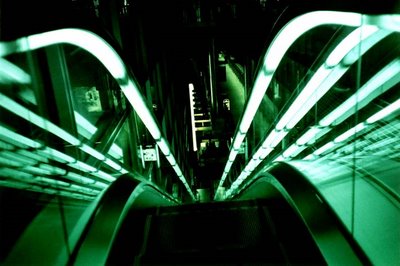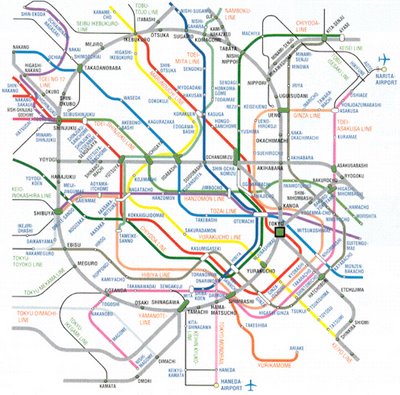This is an old story, but I still like telling it. Japanese researcher Shun Akiba has apparently discovered “hundreds of kilometers of Tokyo tunnels whose purpose is unknown and whose very existence is denied.”
 [Image: From the LOMO Tokyo flickr pool; image by someone called wooooooo].
[Image: From the LOMO Tokyo flickr pool; image by someone called wooooooo].
Shun, who believes he is now the victim of a conspiracy, stumbled upon “an old map in a secondhand bookstore. Comparing it to a contemporary map, he found significant variations. ‘Close to the Diet in Nagata-cho, current maps show two subways crossing. In the old map, they are parallel.'”
This unexpected parallelization of Tokyo’s subway tunnels – a geometrician’s secret fantasy – inspired Shun to seek out old municipal construction records. When no one wanted to help, however, treating him as if he were drunk or crazy – their “lips zipped tight” – he woke up to find his thighs sealed together with a transparent, jelly-like substance –
Er –
Actually, he was so invigorated by this mysterious lack of interest that “he set out to prove that the two subway tunnels could not cross: ‘Engineering cannot lie.'”
But engineers can.
To make a long story short, there are “seven riddles” about this underground world, a secret Subtokyo of tunnels; the parallel subways were only mystery number one: “The second reveals a secret underground complex between Kokkai-gijidomae and the prime minister’s residence. A prewar map (riddle No. 3) shows the Diet in a huge empty space surrounded by paddy fields: ‘What was the military covering up?’ New maps (No. 4) are full of inconsistencies: ‘People are still trying to hide things.’ The postwar General Headquarters (No. 5) was a most mysterious place. Eidan’s records of the construction of the Hibiya Line (No. 6) are hazy to say the least. As for the ‘new’ O-Edo Line (No. 7), ‘that existed already.’ Which begs the question, where did all the money go allocated for the tunneling?”
Shun even “claims to have uncovered a secret code that links a complex network of tunnels unknown to the general public. ‘Every city with a historic subterranean transport system has secrets,’ he says. ‘In London, for example, some lines are near the surface and others very deep, for no obvious reason.'” (Though everyone knows the Tube is a weaving diagram for extraterrestrials).

Further, Shun reveals, “on the Ginza subway from Suehirocho to Kanda,” there are “many mysterious tunnels leading off from the main track. ‘No such routes are shown on maps.’ Traveling from Kasumigaseki to Kokkai-gijidomae, there is a line off to the left that is not shown on any map. Nor is it indicated in subway construction records.”
Old underground car parks, unofficial basements, locked doors near public toilets – and all “within missile range of North Korea.”
What’s going on beneath Tokyo?
(Thanks to Bryan Finoki for originally pointing this out to me! For similar such explorations of underground London, see London Topological; and for more on underground Tokyo, see Pillars of Tokyo – then read about the freaky goings-on of Aum Shinrikyo, the subway-gassing Japanese supercult. And if you’ve got information on other stuff like this – send it in…)